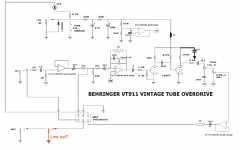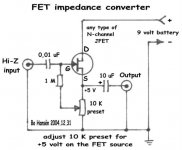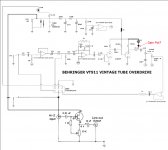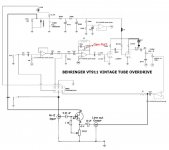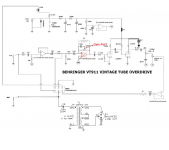Dear all,
I have a preamp tube (behringer vt911) wich (after replacement off the tube) give me full satisfaction. But, I would like to add the only thing missing to my point of vue, which is a line out.
I have add, in attachment, the schematic of it with the additionnal line out (in red).
If I am right, adding a line out is like adding a D.I. (impedance change)? So, I guess I have to add a R.C. somewhere before the line out jack. Could you help me in this?
Thanks
I have a preamp tube (behringer vt911) wich (after replacement off the tube) give me full satisfaction. But, I would like to add the only thing missing to my point of vue, which is a line out.
I have add, in attachment, the schematic of it with the additionnal line out (in red).
If I am right, adding a line out is like adding a D.I. (impedance change)? So, I guess I have to add a R.C. somewhere before the line out jack. Could you help me in this?
Thanks
Attachments
I don't know what you expect of the line output. What impedance do you require? You could connect it where you indicate but its impedance may not be appropriate to your use. What will you use it for? Of course it will be controlled by the volume control, and that may or may not be what you want.
Hello Bob,
Thanks for your answer.
In fact I am willing to use the line-out to connect the preamp directly to a mixer (or recorder). Yes, I guess there 'll be a impedance mismatch and this the reason why I need some advises. How do I change the impedance to a line impedance?
The fact that the level of the line out 'll be controlled by the master volume is something that I want.
Cheers
Thanks for your answer.
In fact I am willing to use the line-out to connect the preamp directly to a mixer (or recorder). Yes, I guess there 'll be a impedance mismatch and this the reason why I need some advises. How do I change the impedance to a line impedance?
The fact that the level of the line out 'll be controlled by the master volume is something that I want.
Cheers
The idea is correct. Take the high impedance signal and run it into an emitter follower (or source follower). Or, an opamp connected as a unity gain amplifier. All will do the job. It depends on what parts you have laying around, etc.
The trouble with that circuit is first, it requires a 9 Volt battery. Second, it's got an adjustment, another nuisance. And third, I don't know its output impedance but I don't think it can drive much. Emitter follower would, I think, be better. Use a 2N2222A for instance, set the bias at around a couple of mA and you are good to go.
The trouble with that circuit is first, it requires a 9 Volt battery. Second, it's got an adjustment, another nuisance. And third, I don't know its output impedance but I don't think it can drive much. Emitter follower would, I think, be better. Use a 2N2222A for instance, set the bias at around a couple of mA and you are good to go.
bob, the unit already has a 9V power supply. The trimpot is no big deal, just set the 5VDC and thats it. The cct is a source follower. The thing I have a problem with is the Behringer cct is running the heaters at 4.5V and 9V as B+. I tried stuff like this 15 to 20 years ago and it never sounded good, the only good sound was what was coming out the guitar speaker. Even with 300V B+, still never achieved a line out sound quality near as good as what came out of the speaker, it's the combination of preamp/tone controls/amp/speaker that makes the good sound in my experience. hacaira you could try that buffer connected to the wiper of the tone control pot and see what happens.
Hi Ian,
Thanks for the infos.
You are right, the sound coming out of the line out 'll never be as good as the sound coming out of a speaker but the purprose is just to be able to record ideas (even at night).
If I am right, the heaters of the double triode are connected in serie and then the 9V becomes 4,5 V in each heater?
What if I change the circuit to use 12V DC? Should it be better? What should be the best B+ voltage then?
Also, I have a NE5532AF (spare) that I could use to make the line out but I don't know how to connect it.
I am willing to upgrade this machine to have the best available sound. I'll change the tube for a Groove tube one and add a +9V output. If you have any suggestion to make it even better, don't hesitate.
Thanks for the infos.
You are right, the sound coming out of the line out 'll never be as good as the sound coming out of a speaker but the purprose is just to be able to record ideas (even at night).
If I am right, the heaters of the double triode are connected in serie and then the 9V becomes 4,5 V in each heater?
What if I change the circuit to use 12V DC? Should it be better? What should be the best B+ voltage then?
Also, I have a NE5532AF (spare) that I could use to make the line out but I don't know how to connect it.
I am willing to upgrade this machine to have the best available sound. I'll change the tube for a Groove tube one and add a +9V output. If you have any suggestion to make it even better, don't hesitate.
Last edited:
Voilà, I made modifications to the original schematic to include the line out.
But I feel like something is wrong. I thaught that there should be a shelf in the circuit in order to change the impedance from 1K Ohm (as reported by Berhinger) to 100 Ohm (line out impedance). Is it the opamp that does this job?
But I feel like something is wrong. I thaught that there should be a shelf in the circuit in order to change the impedance from 1K Ohm (as reported by Berhinger) to 100 Ohm (line out impedance). Is it the opamp that does this job?
Attachments
I think that should work. The place you call gain doesn't seem to be that. The opamp lowers the impedance but has a 1k resistor to protect it. That of course raises the output impedance by 1k.
You could bypass that resistor and have your line out but only when the circuit is operating. Else you will get the line out from your source follower in both modes.
You could modify the circuit to switch the input to the input of the opamp and do away with the source follower. Ib other words, you would disconnect the volume control wiper from the opamp input and connect the input instead.
You could bypass that resistor and have your line out but only when the circuit is operating. Else you will get the line out from your source follower in both modes.
You could modify the circuit to switch the input to the input of the opamp and do away with the source follower. Ib other words, you would disconnect the volume control wiper from the opamp input and connect the input instead.
All this is very interesting. Thanks to all of you for helping me, I learn more each time.
If I am right, the output of the opamp is the right place to connect the line out jack but it 'll only work if the led is on. So I have to install the new circuit only to get the correct output when bypass is on (led is off).
See schematic in attachment (I guess the gain pot is the one indicated in red?)
If I am right, the output of the opamp is the right place to connect the line out jack but it 'll only work if the led is on. So I have to install the new circuit only to get the correct output when bypass is on (led is off).
See schematic in attachment (I guess the gain pot is the one indicated in red?)
Attachments
I don't like that gain method. The bandpass of the amplifier becomes a major issue, and you could be changing the amplifier response as well as inviting oscillation. The volume control on the right is all the gain control you should need. If you find that the system has too much gain, I'd sooner recommend a passive control.
Also, don't connect the outputs of the source follower and opamp together like that. If you use the opamp you can dispense with the source follower.
There are so many options that it's best you decide exactly what you want this thing to do and configure it accordingly.
Also, don't connect the outputs of the source follower and opamp together like that. If you use the opamp you can dispense with the source follower.
There are so many options that it's best you decide exactly what you want this thing to do and configure it accordingly.
When you talk about the gain, is it the one indicated in red?
If yes, this does not seems to be the best schema for gain control and, you are right. The major complain regarding this stompbox is that the gain pot is reacting too strongly (even with a log 500 K pot). I thought it was related to the tube but you might have put your finger on the real cause. Nevertheless, this preamp is used for guitar and should only have responding frequencies from 100 Hz to 4000 Hz (or so). Maybe it is not affecting the sound too much? Anyway, your suggestion is to remove the opamp just under the gain pot? I am right?
Regarding the outputs of the source follower, the 10µF cap is polarized. Is it not enought to protect to source follower?
If I remove the source follower there 'll be big decrease of the signal when the stompbox is switched off (true bypass). I need to have a low impedance signal also when it is off. Any suggestion?
If yes, this does not seems to be the best schema for gain control and, you are right. The major complain regarding this stompbox is that the gain pot is reacting too strongly (even with a log 500 K pot). I thought it was related to the tube but you might have put your finger on the real cause. Nevertheless, this preamp is used for guitar and should only have responding frequencies from 100 Hz to 4000 Hz (or so). Maybe it is not affecting the sound too much? Anyway, your suggestion is to remove the opamp just under the gain pot? I am right?
Regarding the outputs of the source follower, the 10µF cap is polarized. Is it not enought to protect to source follower?
If I remove the source follower there 'll be big decrease of the signal when the stompbox is switched off (true bypass). I need to have a low impedance signal also when it is off. Any suggestion?
I don't know if removing that opamp will sacrifice too much gain. If it works without it, take it out.
The line out is being driven by two amplifiers, which is bad practice. They are conflicting and the output should be a single stage, either the source follower or the opamp on the right. The capacitor isn't the problem.
You will not have true bypass with the power off because the source follower will not work. You need to switch the input to the output and disconnect the rest in order to get a true bypass. Your DPDT switch can do that.
The line out is being driven by two amplifiers, which is bad practice. They are conflicting and the output should be a single stage, either the source follower or the opamp on the right. The capacitor isn't the problem.
You will not have true bypass with the power off because the source follower will not work. You need to switch the input to the output and disconnect the rest in order to get a true bypass. Your DPDT switch can do that.
I did not see the thread before, sorry.
Actually for a line out you need to add a line transformer, nothing more. Take one 10K:600 Ohm, and connect 600 Ohm output to tip and ring of TRS socket; a sleeve end connect to ground.
That's it.
Standard line out to connect to mixer or recording device has to be symmetrical, 600 Ohm. Even if input is 10K and asymmetrical, such an output helps you to eliminate possible interferences because of a ground loop absence.
Actually for a line out you need to add a line transformer, nothing more. Take one 10K:600 Ohm, and connect 600 Ohm output to tip and ring of TRS socket; a sleeve end connect to ground.
That's it.
Standard line out to connect to mixer or recording device has to be symmetrical, 600 Ohm. Even if input is 10K and asymmetrical, such an output helps you to eliminate possible interferences because of a ground loop absence.
Hi Wavebourn,
If I just add a line transformer, when the pedal is switched off, the volume 'll drop down, no? I want the pedal volume to be almost the same on or off.
Regarding the symmetrical connection, you are right, this 'll avoid interferences (specially if the cable to recorder is long).
So now I have to add a line trans. to the previous schema and reconnect it to avoid the signal going to line out to pass by two opamp when the effect is on.
I don't see how to do that without a 3pdt switch. Any suggestion?
If I just add a line transformer, when the pedal is switched off, the volume 'll drop down, no? I want the pedal volume to be almost the same on or off.
Regarding the symmetrical connection, you are right, this 'll avoid interferences (specially if the cable to recorder is long).
So now I have to add a line trans. to the previous schema and reconnect it to avoid the signal going to line out to pass by two opamp when the effect is on.
I don't see how to do that without a 3pdt switch. Any suggestion?
Last edited:
Yes, such a way when you switch off an effect your guitar's output is loaded on a transformer. I would suggest you to take direct output from the 1'st opamp (buffer) instead of from input.
Also, why do you crossed out by red a stage that overdrives tubes and allows to control overdrive?
Also, why do you crossed out by red a stage that overdrives tubes and allows to control overdrive?
Yes, such a way when you switch off an effect your guitar's output is loaded on a transformer.
Does it mean that the volume level 'll be acceptable when effect is off?
Also, why do you crossed out by red a stage that overdrives tubes and allows to control overdrive?
Well, the idea was that it might be obsolete. If the overdrive is only controlled by a pot, is it not enought? In fact I was looking for the reason why the overdrive is raising so quickly (after turning the pot just a little bit).
I 'll redraw and post it soon.
Does it mean that the volume level 'll be acceptable when effect is off?
Also, why do you crossed out by red a stage that overdrives tubes and allows to control overdrive?
Well, the idea was that it might be obsolete. If the overdrive is only controlled by a pot, is it not enought? In fact I was looking for the reason why the overdrive is raising so quickly (after turning the pot just a little bit).
I 'll redraw and post it soon.
- Status
- This old topic is closed. If you want to reopen this topic, contact a moderator using the "Report Post" button.
- Home
- Live Sound
- Instruments and Amps
- adding line out to guitar tube preamp
